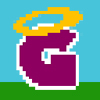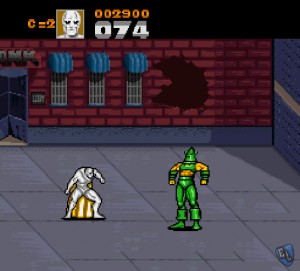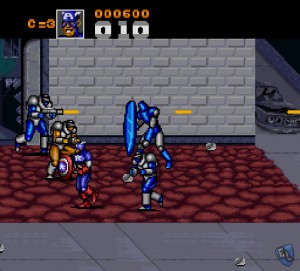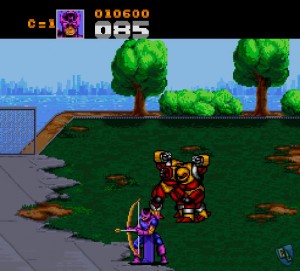The GodisaGeek Retro Corner: Captain America And The Avengers
 Game: Captain America And The Avengers (1993)
Game: Captain America And The Avengers (1993)
Developer: Data East
Publisher: Mindscape Inc.
Originally Released on: Arcade, NES, Super NES, Mega Drive, Game Gear, Game Boy
Currently Available on: Currently Unavailable
With a new Comic book film, comes the inevitable tie-in game. Whilst these are often complete dross (despite the recent Green Lantern game being fairly decent), they are not a new thing, and bad adaptations have been in production for a long time. Sometimes the game developers go for a more direct approach, and release a game that is a direct adaptation of the Comic source material. This can wind up being a much more exciting affair, as was shown with the great success of Batman: Arkham Asylum. With the impending release of a new Captain America film, and the tie-in game release from SEGA, the GodisaGeek Retro Corner is going to take you back to 1993, when Captain America made a splash on home consoles in a game that wasn’t movie related in any way. Taking aim with his Mighty Sheild, does Cap’ hit or miss?
 Captain America And The Avengers is a 2D side-scrolling beat-em-up, in the traditions of such of Comic-book games as the X-Men Arcade game and the Teenage Mutant Ninja Turtles games – both from Konami. This seems to have been the genre of choice when it came to adaptations of TV and Comic property rights in the late eighties and early nineties. Whilst the majority of stages are played in this style, there are side-scrolling shoot-em-up-style levels interspersed inbetween. These take place when The Avengers take to the air, or are swimming underwater, and gameplay reverts to a simple button-hammering “shmup” format, shooting down incoming enemies.
Captain America And The Avengers is a 2D side-scrolling beat-em-up, in the traditions of such of Comic-book games as the X-Men Arcade game and the Teenage Mutant Ninja Turtles games – both from Konami. This seems to have been the genre of choice when it came to adaptations of TV and Comic property rights in the late eighties and early nineties. Whilst the majority of stages are played in this style, there are side-scrolling shoot-em-up-style levels interspersed inbetween. These take place when The Avengers take to the air, or are swimming underwater, and gameplay reverts to a simple button-hammering “shmup” format, shooting down incoming enemies.
Players can choose from four heroes from the traditional Avengers line-up to play as; Captain America himself, the Invincible Iron Man, Hawkeye – deadly accurate with a bow, and the android crime-fighter – the Vision. All of the characters have more or less the same jump and punch abilities, with their own long-range attack style and a dashing attack. Whilst these attacks all look different and make use of the individual weapon related to each character, they are similarly powered and cover the same distance as one another, so the variation from hero to hero is purely cosmetic. The game can be played across three difficulty levels, and users can also adjust the number of continues they start off with.
 It must be said that between the original arcade machine version and the console port, there has been a significant loss of graphical integrity. In the arcade original, the backgrounds appear as highly detailed, watercolour hand painted backdrops. These really evoke the feeling of playing in a living comic book. However, for the home conversion, these have been replaced by flat, dull, pixelated backgrounds, that are largely lifelike and very generic from level to level. The immediate impact that the painted style originals had is completely lost, and this could just be any other game when played on console – there is little to characterise the stages and really make it seem like a Marvel comics game.
It must be said that between the original arcade machine version and the console port, there has been a significant loss of graphical integrity. In the arcade original, the backgrounds appear as highly detailed, watercolour hand painted backdrops. These really evoke the feeling of playing in a living comic book. However, for the home conversion, these have been replaced by flat, dull, pixelated backgrounds, that are largely lifelike and very generic from level to level. The immediate impact that the painted style originals had is completely lost, and this could just be any other game when played on console – there is little to characterise the stages and really make it seem like a Marvel comics game.
The character sprites, both for players and enemies, are all quite small. Whereas other developers such as Konami seemed to always use large, bold sprites, Data East have created more compact ones here. This does mean that a certain level of detail is lacking, when compared to other side-scrolling fighters, but it is still clear to see the difference between each character model, and the jumping and attacking animations, for example, are clear and well drawn. A nice added touch is that for both the hero and enemy boss characters who have a health bar on-screen, a small corresponding character face icon is displayed next to the health meter. When that person takes damage, this face icon reacts and appears hurt or angry. Cut-scenes are all delivered as comic panels, with text to explain them, and whilst not being very detailed, are dynamic and evoke the feel of the source material. This is further brought out with the use of Batman-style “Pow” and “Wham” exclamations, with over-the-top explosions when enemies are defeated. These are nice little details that add nothing to the gameplay, but do show a certain attention to detail and immersion – despite the low quality backgrounds.
 The same can not be said for the sound in-game. The music is very generic, with simple hero-style themes running through every level and cutscene – repeatedly. They soon become boring and repetitive, with the same monotonous bleeps and bloops being looped over and over. Admittedly, this is an old game, but the themes are not even catchy or varied, they are all simply re-workings of the same basic themes. Digitised voices are also sprinkled throughout the title, as was the style at the time; a lot of arcade games tried to insert a little speech as this was a very modern and cutting-edge idea. The voices have been quite poorly digitised, and the selection of speech is poor, so every time you are hit, the same “umph” noise replays, becoming quite irritating. Further to that, all digital voices, from the level start voiceover, to Captain America or any other hero, are all identical. It may have been better to simply leave out these voices entirely.
The same can not be said for the sound in-game. The music is very generic, with simple hero-style themes running through every level and cutscene – repeatedly. They soon become boring and repetitive, with the same monotonous bleeps and bloops being looped over and over. Admittedly, this is an old game, but the themes are not even catchy or varied, they are all simply re-workings of the same basic themes. Digitised voices are also sprinkled throughout the title, as was the style at the time; a lot of arcade games tried to insert a little speech as this was a very modern and cutting-edge idea. The voices have been quite poorly digitised, and the selection of speech is poor, so every time you are hit, the same “umph” noise replays, becoming quite irritating. Further to that, all digital voices, from the level start voiceover, to Captain America or any other hero, are all identical. It may have been better to simply leave out these voices entirely.
But the main issues with the game lie simply in its gameplay. The game, like its audio work, is repetitive and unexciting. Firstly, the difficulty of the game is very low, even on the harder settings. Enemies will often simply advance onto your ranged attacks and offer very rigid patterns of attack. It may sound unusual, but some of the lesser enemies (ranged ones in particular) are far tougher than the so called boss battles. This is because they spam cheap attacks at you, which are often hard to avoid without jumping constantly around the screen. The enemies also repeat from level to level. The only variety is that the colour of the bad guys changes to suit the new stage. There is still always a long-range enemy, a shield-carrying enemy, and one who has a large claw that can grab players and hold them immobile for several seconds. This even extends to bosses! They all carry the same old attacks. This is an exception on the “shmup” levels, where we get the same old enemies, but now flying some kind of floating jet-ski. There is no real variety in these levels though, and the same enemies are repeatedly hurled at the player, and by simply tapping fire constantly, one could reach the boss with little to no effort.
 The bosses in these shooting levels are slightly more imaginative, as since you are now floating, the developers can introduce gigantic enemies, who would be too big to portray in a normal environment. So we get the head and shoulders of a huge Sentinel hurling rockets at The Avengers, or a massive Octopus floating underwater, attacking our heroes. These bosses are far harder, as they fling attacks at you from all angles, but once an effective pattern is learnt, they can soon be dispatched. Most of the bosses are recognisable to fans of the comics, but some are definitely quite obscure by today’s standards – Whirlwind is hardly one of the most feared Marvel villains.
The bosses in these shooting levels are slightly more imaginative, as since you are now floating, the developers can introduce gigantic enemies, who would be too big to portray in a normal environment. So we get the head and shoulders of a huge Sentinel hurling rockets at The Avengers, or a massive Octopus floating underwater, attacking our heroes. These bosses are far harder, as they fling attacks at you from all angles, but once an effective pattern is learnt, they can soon be dispatched. Most of the bosses are recognisable to fans of the comics, but some are definitely quite obscure by today’s standards – Whirlwind is hardly one of the most feared Marvel villains.
The plot is nearly non existent, with the motivation for each stage simply to find the boss and defeat them – Red Skull having brainwashed a group of evil doers to do his bidding. Defeat every bad guy and then get to Red Skull and stop his plot. Between levels we get maybe one or two comic panels to perpetuate the story, but it is very basic. This does lead to the whole game feeling very samey, with little reason to want to finish each level. There isn’t much satisfaction to be taken from dispatching the same henchman for the three-hundredth time, and the boss battles, as mentioned before, are a big anti-climax. There didn’t need to be a hugely immersive story, as shown by side-scrolling games such as Final Fight, but the fighting mechanics should be a little more robust and the variation in levels more exciting.
In the same way that early comic books seem to re-hash the same situation over and over every week, Captain America And The Avengers doesn’t surprise gamers. After you have played the first couple of levels, you have already seen most of what this game has to offer, and it certainly doesn’t get any better from there on in. Whilst games like Turtles in Time and Sunset Riders offered bonus stages, weapons upgrades and enemies who got progressively higher-powered as you progressed in the game, this title is more or less the same all the way through. It will undoubtedly appeal to fans of the characters due to the nicely executed sprites and co-op multiplayer action, but even then, the excitement of four-player with all of The Avengers teaming up has been lost in the move from the arcade to the console. This is probably a good thing though, because if the game is this easy with only two players, just think how simple it would be with four heroes fighting the same cause. Let us hope that SEGA can produce something more worthy of the Captain America name, as for such an iconic hero, he has been long overlooked in gaming circles.
Captain America And The Avengers is currently unavailable to purchase new, but can be bought second hand from sites such as eBay. The God is a Geek Retro Corner is part of “Feature Friday” and will return on the first Friday of next month. You can see previous entries into the GodisaGeek Retro Corner by clicking here.





